
|
Deaths Scenes 1983 |


|
Christine (1983) Director John Carpenter's cult film was an adaptation of Stephen King's best-selling 16th book (and 14th novel), of the same name. It told about an evil-possessed red and white 1958 Plymouth Fury malevolent car (named Christine), with California plates: CQB 241. The story was set in the late 1970s, when nerdy high school student Arnie Cunningham (Keith Gordon) purchased the car for $250. One of Arnie's enemies, angry, long-haired bully Buddy Reperton (William Ostrander) became Christine's latest target and he trashed the car. Christine regenerated herself, and then sought wrathful revenge. Christine pursued Buddy's vehicle, and then crashed into it and pushed it into a Mobico gas station's repair garage. Leaking gasoline ignited flames. Now completely engulfed in flames, Christine backed out of the garage, smashed into the gas pumps (causing a massive set of explosions and killing Buddy's friend), and chased Buddy on foot down a highway. Christine caught up to Buddy, drove over him and left him a flaming corpse lying in the middle of the country road.
Christine similarly stalked gray-sweatshirted, overweight Moochie Welch (Malcolm Danare) into a narrow alleyway. There, the car cornered him and paused, as Moochie pulled out a switchblade and ineffectually threatened: "You're a dead man, now." Christine revved up her engines, squeezed into the narrow space (stripping off its edges and side panels), and pinned him against a wall - crushing him to death. Later, a detective explained that the victim was cut in half. |
     Christine Crushing Moochie |
|||||||||
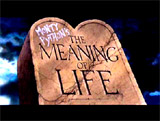
|
Monty Python's The Meaning of Life (1983, UK) The British sketch troupe of Monty Python created this comedy film to cover the seven stages of life. "Part VI: The Autumn Years" had one of the greatest death scenes ever filmed. It was the oft-remembered, gruesome death scene of the slovenly, massively overweight, constantly-vomiting character of Mr. Creosote (Terry Jones) after his overeating (a "double helping") during a multi-course meal, served in a bucket. His behavior caused many of the other customers in the fancy French restaurant to be sickened or leave early. With his table piled high with plates and throw-up everywhere, his determined waiter offered one last item: "Finally, monsieur, a wafer thin mint...It's only a tiny little thin one" - to end the meal. When Creosote argued: "F--k off, I'm full... I couldn't eat another thing. I'm absolutely stuffed," the waiter persuasively said: "Just, just one." When the engorged man was fed the mint wafer, he chewed and swallowed it. The waiter concluded the meal with a wishful "Bon appétit." Creosote began to swell as the waiter ran for cover, and the familiar Jaws music played. His table was soon overturned by his expanding girth. The restaurant's other customers were showered with his insides and half-digested food when his stomach burst in spectacular fashion. His fat-coated, still-beating, enlarged heart was revealed outside of his chest (and its exposed rib cage) as the waiter ceremoniously presented him with the check, and then happened to notice the undigested mint inside Creosote's body cavity -- he delicately plucked it out and popped it in his mouth. |
    Mr. Creosote's Swelling and Bursting |
|||||||||

|
Monty Python's The Meaning
of Life (1983, UK) This best death scene was taken from "Part VII: Death" of the comedy film. An off-screen narrator explained how criminal Arthur Charles Herbert Runcie MacAdam Jarrett (Graham Chapman) was offered execution by a method of his own choosing:
The governor explained Jarrett's crime - at his beachside grave:
As punishment, he had selected a mad dash-pursuit by a group of beautiful bare-chested women (with brightly colored crash helmets and kneepads matching their thong-bikini bottoms) who (with frequent panting) would chase him off a cliff to his death.
He plummeted into his own gravesite where a funeral ceremony for his death was already being held. The priest intoned: "Ashes to ashes, dust to dust." |
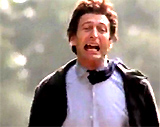 Arthur Jarrett's Mad-Dash to Cliffside 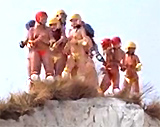 Job Accomplished  The Gravesite |
|||||||||
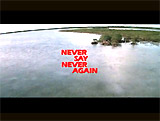
|
This British Bond spy film was considered mostly a remake of Thunderball (1965). Ex-Bond star Sean Connery - who hadn't played Bond in 12 years, returned to the franchise series with this unofficial entry. The main plot was about the evil organization of SPECTRE, whose terrorist operative Largo (Klaus Maria Brandeur) and one of his fellow associates (Number 12), the sexy Bond 'Bad' Girl Fatima Bush (Barbara Carrera), had successfully stolen two nuclear weapons from the US military. The domineering, deranged and sadistic Fatima met up with Agent 007 (Sean Connery) and attempted to kill him numerous times, but failed twice:
When she cornered him at gunpoint after knocking him off his motorbike, she ordered: "Spread your legs" and threatened to shoot his crotch:
In the midst of a violent temper tantrum about being spurned, she commanded him to write a note on a scrap piece of newspaper about her love-making abilities, dictating: "The greatest rapture in my life was afforded me on a boat in Nassau by Fatima Blush. Signed, James Bond 007." Bond quipped: "I just remembered, it's against Service policy for agents to give out endorsements." She blurted back: "WRITE!" Fatima met her demise when Bond fired a miniature rocket grenade into her chest from his Union Jack-decorated projectile fountain pen. She cackled, believing she was still alive, but then the grenade exploded, leaving only her charred high-heels behind. |
 Fatima (Barbara Carrera)  Bond Firing Explosive Grenade From Pen   Fatima's Smoldering High-Heels |
|||||||||
 
|
In the climax of the entire trilogy, the dark lord Darth Vader (David Prowse, voice of James Earl Jones) struggled in a light-saber duel against his son, Jedi Knight Luke Skywalker (Mark Hamill). Vader had earlier revealed in The Empire Strikes Back (1980) that he was Luke's father, named Anakin Skywalker, who had been converted to the dark side. Vader saved his son from dying at the hands of the evil Emperor (Ian McDiarmid) by hurling the evil leader down a long shaft in the Death Star battle station, where his body exploded in a burst of energy. Mortally-wounded and breathing laboriously, Vader then asked Luke to remove his mask-respirator, but Luke protested: "But you'll die!," to which Vader responded: "Nothing can stop that now. Just for once, let me look on you with my own eyes." When he removed his father's mask, Luke saw the face of a sad elderly, bald man with a scarred, white face who ordered Luke to flee the Death Star with his last dying breaths: "Now, go, my son. Leave me." Luke disagreed, and vowed to save his father: "I've got to save you." Vader replied: "You already have, Luke...You were right about me. Tell your sister you were right."
And then Vader died. Luke escaped from the exploding Death Star in the shuttle with his father's corpse, and that evening on the forest moon of Endor (as the rebels celebrated the destruction of the new Death Star and the demise of the Emperor), Luke burned the armored body in a funeral pyre. Later, Luke saw the happy ghost-spirits of Ben "Obi-Wan" Kenobi (Alec Guinness), Jedi master Yoda and then Anakin (Sebastian Shaw) smiling upon him - and he waved them goodbye. |
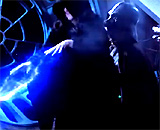  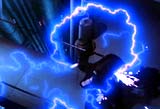  Death of Evil Emperor  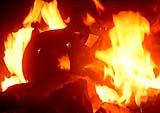 Vader's Funeral Pyre  'Ghost-spirits' |
|||||||||

|
Rock & Rule (1983, Canada) In a post-apocalyptic US setting in this off-beat, adult-oriented, feature-length animated Canadian film, arrogant, aging Mick Jagger-like rock musician star named Mok Swagger (voice of Don Francks, singing voice of Lou Reed) died. During a comeback concert performance in Ohmtown, the villainous, egomaniacal Mok attempted to summon an all-consuming, blue-eyed, long-toothed demon from another dimension so that he could take over the world. Mok found that the singing voice of keyboardist Angel (voice of Susan Roman, singing voice of Deborah 'Blondie' Harry) would unlock the portal gateway and allow the demon entry, so he abducted her to use her voice. However, in the film's incredible conclusion, the demon was forced to retreat and was sent back through a portal gateway by the harmonized singing of the heroic duo of punk-rock lead singer-guitarist Omar (voice of Paul Le Mat, singing voice of Robin Zander) and Angel, singing "Send Love Through." A vengeful Toad (voice of Chris Wiggins), whose self-sacrificing, heroic brother Zip was killed by the demon and died in his arms, harshly growled at Mok: "My brother's dead..." and then hurled Mok into the pentagonal dimensional portal as Mok screamed back in anger:
Mok managed to climb to the side of the portal, where he confessed that he had misinterpreted a Satanic computer prophecy (voice of Samantha Langevin) about how the demon could be sent back:
It meant that "no one" could send him back, but two singers together could provide the counter-spell. Mok lost his grip and fell into the abyss, as the portal vanished to reveal the plain concrete floor of the stage. |
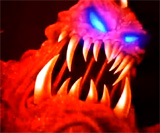 The Emergence of the Demon Creature  Death of Zip in Toad's arms  Angel and Omar Singing Duet "Send Love Through"  Mok Thrown Into Portal by Toad  Death of Mok Swagger |
|||||||||

|
Scarface (1983) Director Brian De Palma's violent gangster film and crime drama was a remake of the original and classic film by Howard Hawks, Scarface: The Shame Of A Nation (1932). Tribute was paid to the original film - it starred Al Pacino as the scar-faced title character Tony Montana - who was redefined as an exile from Castro's Cuba to Florida in the early 1980s. One of the most intense, infamous and controversial dismemberment scenes ever recorded occurred in this film. During a bad drug deal with Colombians, red-shirted recent Cuban refugee Tony Montana (Al Pacino) was forced to watch as his friend Angel Fernandez (Pepe Serna) was chain-sawed to death (off-screen with bloody splattering and spray dotting his face). Angel was hanging by his wrists in a hotel bathroom shower as he was mutilated. Tony was saved from the same fate when his associates Manny Ribera (Steven Bauer) and Chi Chi (Angel Salazar) stormed the apartment with guns blazing and rescued him. |
 Angel Fernandez   Tony Witnessing Chain-Saw Death 
|
|||||||||

|
Scarface (1983) The one-man army of Tony Montana (Al Pacino) faced a bloody fatal standoff at his mansion, armed with an M16 (and a grenade launcher). The scene began with Tony snorting a huge amount of cocaine (lying in white powdery stacks on his office desk), as one of the thugs hired by Bolivian cocaine kingpin Alejandro Sosa (Paul Shenar) was secretly infiltrating onto his balcony. Tony's heavily-drugged sister Gina Montana (Mary Elizabeth Mastrantonio), dressed in an open purple gown with only panties, entered his office. She was intent on retaliating for Tony's earlier senseless assassination of his own associate, Manny, whom Gina had just married. She taunted him by offering her deadly self:
One of Gina's many shots struck Tony in the leg as she came closer and closer ("Oh, come on, Tony. F--k me, huh? F--k me, Tony!") - he cowered behind his desk chair. Suddenly, the gunman from the balcony burst into the room and killed Gina with a blast of machine-gun fire. Tony charged the killer, tossed him into the plaza's fountain below, and riddled his body with bullets ("Die, Die!"). After commiserating over Gina's dead body (Tony promised her, "You wait for me, I'm coming back"), Tony realized what was happening as his courtyard filled with armed men. He viewed his closed-circuit TV security cameras and watched as his residence was being surrounded and his security guards were being murdered outside his locked office.
Coke-convulsed Tony took a one-man stand in the bloody finale against overwhelming odds, uttering the famous challenge with his super-charged weapon in his hands: "OK. You wanna play rough? OK. Say hello to my little friend!" as he shot down gunmen crouched at his door. He taunted: "You want more?" Emerging from his office, he sprayed everyone in sight with bullets, although he was wounded in the left shoulder. When he was hit a second time, he tried to shield himself with the bodies of the dead littering the floor around him. After killing almost all his opponents, Tony shouted:
Daring to be shot ("I take your f--kin' bullets!"), Tony was gunned down by a barrage of fire from his staircase lobby, and with one final point-blank shotgun blast in the back administered by Skull (Geno Silva), Sosa's personal assassin. Tony's bullet-ridden body crashed down one story from the top of his staircase into his indoor fountain, where his corpse floated in front of a statue with the neon slogan: "The World Is Yours." |
 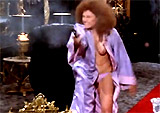 Gina Threatening Tony   Tony's Sister Gina Machine-Gunned |
|||||||||

|
Star 80 (1983) Playboy Playmate Dorothy Stratten (Mariel Hemingway) was tragically murdered by jealous, abusive, and suffering husband/manager Paul Snider (Eric Roberts), in the house that they had rented together in North Hollywood. After her estranged husband forced her to have sex, the beserk partner killed her with a shotgun and then committed suicide with the same bloody gun. The film basically intercut bits and pieces of the gory and despairing scene of the concluding double murder-suicide, foreshadowing what would eventually occur, as it told about Stratten's rise to fame in flashback, and Snider's descent into jealous and spiteful madness:
Dorothy eventually demanded a divorce from Snider: "I want more freedom...Things change. I'm not the same girl I was in Vancouver." She became estranged from Snider and was dating director Aram Nicholas (Roger Rees) (a fictionalized version of Peter Bogdanovich who directed her in They All Laughed (1981)). She met with Snider in their home, where she proposed leaving him half of her savings ($7,000), and refused to respond to Snider's plea to return to "make it like it was before." She was dismayed when he admitted he had bought a gun, and was contemplating suicide. He refused to let her leave, as she kept wishing: "I think we should break cleanly...I want it to be over." As she was about to leave, she heard Paul in the next room cock his shotgun. She investigated, and as she tried to console his self-destructive urges, he threw her on the bed and threatened rape (while accusing her of having slept with her director Aram the night before). But then as he backed off, she slowly undressed and sat naked before him. He mocked her: "You're gonna do me a big favor, huh? Okay, that's me, a charity case. (He forced her onto the bed, laid naked on top of her and began to have intercourse) Now try to think of dear Aram if you can." After getting off of her and rolling her onto the floor, he continued having sex, but then shook his head, realizing that their good times were really over - he was reminded by the many photos on them from happier times pinned to the wall around them. He reached for his shotgun and pointed the muzzle next to her cheek, as he blamed everyone else for their tragic end: "Can you hear me? They did this." He pulled the trigger, causing blood to splatter onto one of Dorothy's pictures. He eulogized her: "My queen," but then strapped Dorothy's corpse to a padded exercise-bench and anally-raped her. As he violated her, he recalled provocative nude images of her taken in the past. With his bloody hand, he then reached for the shotgun, loaded it, quipped: "You won't forget Paul Snider," and blew his brains out. From a top view, the camera pulled back from the bloody scene.
|
   Prelude to the Murder   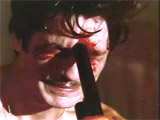  Suicidal Double Murder |
|||||||||
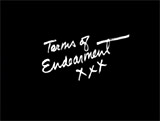
|
Terms
of Endearment (1983) Writer/director/producer James L. Brooks' (his first directorial effort) Best Picture-winning film was based on the novel of the same name by Larry McMurtry. It told about the thirty-year mother-daughter relationship between two women:
One of the most tear-jerking death scenes ever recorded was in its conclusion. Emma succumbed to cancer just after a final goodbye to her children by her hospital bed, telling her eldest son Tommy (Troy Bishop):
This scene was followed by her death, in which she gave her mother Aurora a silent smile while her husband Flap (Jeff Daniels) dozed next to her in a chair, then passed away so quietly it went unnoticed by Aurora until a nurse announced her death to the two. Aurora then sobbed piteously to Flap:
|
 Emma (Debra Winger)  Goodbye to Her Sons 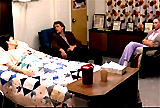   Emma's Last Glance at Mother |
|||||||||
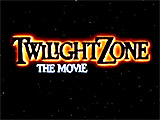
|
Twilight Zone: The Movie (1983) - The Prologue In the film's funny, shocking, opening 8-minute vignette, a car passenger (Dan Aykroyd) and driver (Albert Brooks) were singing-along-to Creedence Clearwater Revival's "The Midnight Special" on a cassette. They challenged each other with trivia games (guessing various TV theme songs, e.g. Sea Hunt, Car 54, and Hawaii Five-O, and classic Twilight Zone episodes) while they passed through mountains late at night. The passenger finally asked:
Then after the car was pulled over to the side, the driver turned and said "Scare me." The passenger suddenly transformed into a roaring and monstrous hag with long teeth and promptly throttled the driver to death, as the familiar Twilight Zone theme song was heard on the soundtrack. |
  
|
|||||||||

|
Twilight Zone: The Movie (1983) - Segment 3 In this third segment (of four) directed by Joe Dante and based on the classic Twilight Zone episode "It's a Good Life" by Jerome Bixby, a sibling named Ethel (Nancy Cartwright) suffered a chilling cartoonish death. The story was about a spoiled, omnipotent, strange young child named Anthony (Jeremy Licht) who had special, god-like eerie mental powers - whatever he wished for would happen. In the house where he lived with his entire 'family' and sister Ethel, there was a TV in every room broadcasting Anthony's favorite cartoons (he said that he only liked cartoons: "Nothing else is as good. Anything can happen in cartoons"). The house had very subtle cartoon-like pastel colors, while the upper floor was gray with a portrait hanging on the wall of a family of blank faces. In one of the upper floor rooms, another of Anthony's sisters, Sara (Cherie Currie) (who was watching a cartoon on TV) literally had no mouth, after he had wiped the mouth off her face (so that she couldn't "yell at him anymore"). Anthony claimed that "she was in an accident." Later, Ethel also stated that Anthony had spitefully wiped clean the faces of his 'real' family. Anthony was so self-centered and controlling that at dinner, everyone had to eat his favorite foods (ice cream, candy apples, potato chips, and hamburgers with peanut butter topping) - whatever he wanted - even if it seemed to always be a birthday supper. When Anthony's sister Ethel complained it was "another birthday, with presents and wishes", he overturned her plate. It soon became obvious that Anthony had actually entrapped everyone and was terrifying his 'family' in the house. His real parents had not set any limits on his actions, and he was entirely in charge. No disagreements, criticisms, or negative emotions were allowed. He admitted he had bizarre and maniacal powers: "I can make it real nice here. I can make the food just the way you said it should be. I can even change the house. Just say it and I can make whatever you like." Then, he noticed a warning that had written about him:
When Anthony's blonde sister Ethel was accused by all of the others of writing the note, and admitting that they were all being held against their will in the house, she was teleported into a deadly, surreal TV "Cartoon Hell." Anthony sent her into a cartoon world to be eaten ("I'm wishing you into cartoon-land"). He assured her: "I told you cartoons were good. Anything can happen."
Ethel was tormented by a wolf in the cartoon that transformed itself into a dragon-like lizard, as Anthony chuckled to himself. She was told to "Run!", but she found herself devoured and trapped in the mouth of the grotesque, green lizard devil that licked its toothy chops after consuming her. Anthony darkly taunted in the style of Porky Pig:
|
 Anthony  Anthony's 'Real' Family  Mouth-less Sara  Anthony's Entrapped 'Family'  Anthony's Spiteful Sister Ethel  Anthony Teleporting Ethel into Cartoon-Land  "Th-th-th-that's all, Ethel." |
|||||||||
(chronological by film title) Intro | 1915-1929 | 1930-1933 | 1934-1938 | 1939 | 1940-1942 | 1943-1945 | 1946-1947 | 1948-1949 1950-1952 | 1953-1955 | 1956-1957 | 1958-1959 1960-1961 | 1962-1963 | 1964-1966 | 1967-1968 | 1969-1970 1971 | 1972 | 1973 | 1974 | 1975 | 1976 | 1977-1978 | 1979 1980 | 1981 | 1982 | 1983 | 1984 | 1985 | 1986 | 1987 | 1987 | 1988 | 1989 1990 | 1991 | 1992 | 1993 | 1994 | 1994 | 1995 | 1995 | 1996 | 1997 | 1998 | 1998 | 1999 2000-2001 | 2002 | 2003 | 2004 | 2005 | 2006 | 2007 | 2008 | 2009 | 2010 | 2011 |